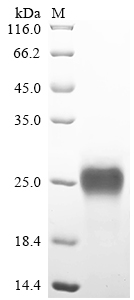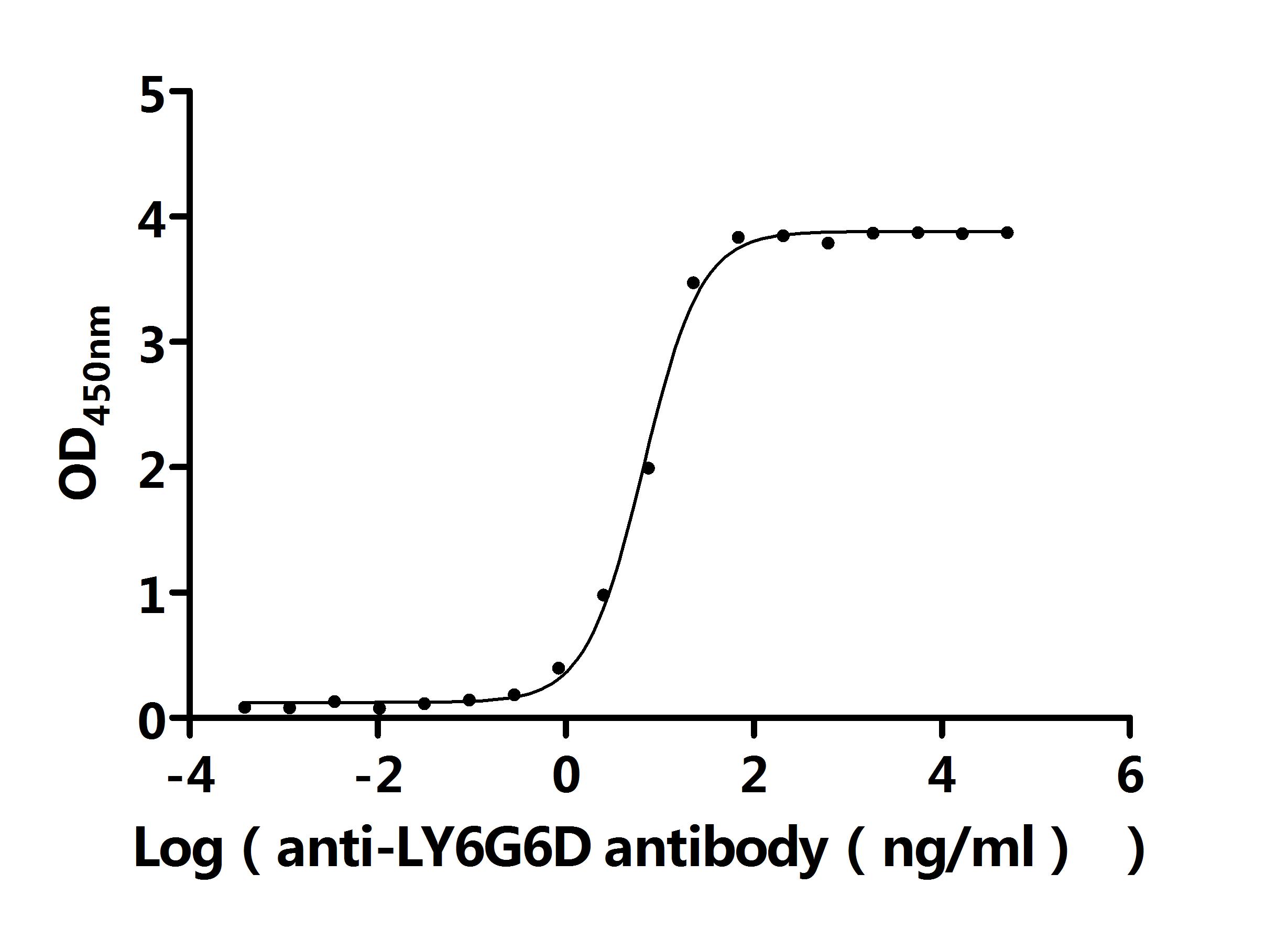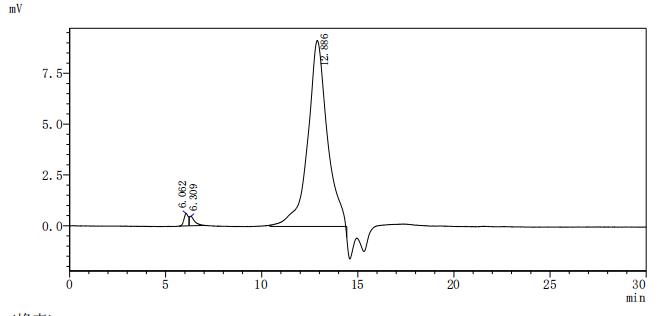The recombinant rat Ly6g6d protein is an active, high-purity molecule produced in a yeast expression system, ensuring proper protein folding suitable for functional applications. It includes amino acids 20 to 108 of the native Ly6g6d sequence and is engineered with an N-terminal 6xHis tag to support efficient purification and detection. Available either in liquid or lyophilized form, this recombinant Ly6g6d protein demonstrates a purity greater than 95%, confirmed by both SDS-PAGE and SEC-HPLC. Functional activity is validated in a binding ELISA, where the immobilized Ly6g6d at 2 μg/mL specifically interacts with the anti-Ly6g6d recombinant antibody (CSB-RA013246MA4MO), showing an EC50 between 6.238 and 7.258 ng/mL. These properties make it a reliable tool for antibody screening, immune response research, and studies involving Ly6 family proteins.
The Ly6g6d protein has been implicated in various aspects of tumor biology, particularly in colorectal cancer (CRC). This glycosylphosphatidylinositol (GPI)-anchored protein is primarily expressed in colorectal tumors and has been found to play a significant role in modulating immune responses within the tumor microenvironment.
Recent studies have highlighted the upregulation of Ly6g6d in specific subtypes of CRC, particularly in microsatellite stable (MSS) tumors characterized by low expression of immune checkpoint receptors like PD-1/PD-L1 and an abundance of regulatory T cells (Tregs) [1][2]. This expression pattern suggests that Ly6g6d might contribute to a tumor-immune evasion mechanism, preventing effective anti-tumor responses by suppressing immune activity [3][2]. Furthermore, the modulation of Ly6g6d expression has been linked to pathways such as the AKT/p38 MAPK signaling pathway, indicating its involvement in the molecular signaling frameworks that govern immune responses in CRC [4][5].
Moreover, Ly6g6d's epigenetic regulation through DNA methylation processes further complicates its functional role. In certain mucinous subtypes of CRC, hypermethylation of the Ly6g6d gene may lead to diminished expression, thereby facilitating immune suppression and resistance to therapies such as FOLFOX [6][7]. This notion is corroborated by findings that suggest a correlation between increased Ly6g6d expression and enhanced immune infiltration in the tumor microenvironment, indicating that its expression might act as a double-edged sword, promoting immune recognition in some contexts while allowing tumor tolerance in others [2][7].
Additionally, the role of Ly6g6d as a potential target for immunotherapeutic strategies is gaining traction. Studies investigating bispecific antibodies targeting Ly6g6d have demonstrated promise in redirecting T-cell responses toward CRC cells, suggesting that manipulation of Ly6g6d expression or function could improve treatment outcomes by enhancing the immunogenicity of otherwise “immune-cold” tumor phenotypes [3][8]. Notably, the expression of Ly6g6d is not only a marker of tumor progression but also a promising biomarker for tailoring therapies aimed at optimizing anticancer immune responses, underscoring the need for further investigation into its functional mechanisms and therapeutic potential [2][7][8].
References:
[1] H. Liu, S. Chen, et al. Spatially resolved transcriptomics revealed local invasion-related genes in colorectal cancer. Frontiers in Oncology, vol. 13, 2023. https://doi.org/10.3389/fonc.2023.1089090
[2] L. Corrales, S. Hipp, et al. Ly6g6d is a selectively expressed colorectal cancer antigen that can be used for targeting a therapeutic t-cell response by a t-cell engager. Frontiers in Immunology, vol. 13, 2022. https://doi.org/10.3389/fimmu.2022.1008764
[3] P. Wang, L. Sun, et al. Novel anti-ly6g6d/cd3 t-cell–dependent bispecific antibody for the treatment of colorectal cancer. Molecular Cancer Therapeutics, vol. 21, no. 6, p. 974-985, 2022. https://doi.org/10.1158/1535-7163.mct-21-0599
[4] R. Luo, H. Li, et al. Shengqiyichang decoction regulates antitumor immunity in colorectal cancer by downregulating lymphocyte antigen 6 family member g6d via the protein kinase b/p38 mitogen-activated protein kinase signaling pathway. Heliyon, vol. 10, no. 21, p. e39071, 2024. https://doi.org/10.1016/j.heliyon.2024.e39071
[5] F. Caruso, M. D’Andrea, et al. Lymphocyte antigen 6g6d-mediated modulation through p38α mapk and dna methylation in colorectal cancer. Cancer Cell International, vol. 22, no. 1, 2022. https://doi.org/10.1186/s12935-022-02672-1
[6] F. Caruso, M. D’Andrea, et al. Ly6g6d is epigenetically activated in classical colorectal adenocarcinoma and hyper-methylated in mucinous subtypes determining resistance to folfox therapeutic regimens. 2021. https://doi.org/10.21203/rs.3.rs-783534/v1
[7] S. Amniouel and M. Jafri. High-accuracy prediction of colorectal cancer chemotherapy efficacy using machine learning applied to gene expression data. Frontiers in Physiology, vol. 14, 2024. https://doi.org/10.3389/fphys.2023.1272206
[8] P. Li and D. Huang. Targeting the jak-stat pathway in colorectal cancer: mechanisms, clinical implications, and therapeutic potential. Frontiers in Cell and Developmental Biology, vol. 12, 2024. https://doi.org/10.3389/fcell.2024.1507621






